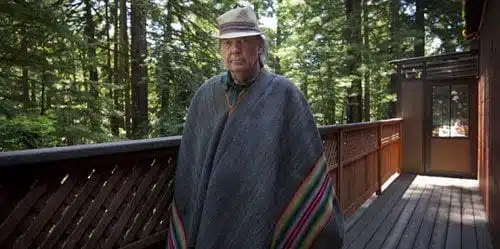
Psychedelic Pill is Neil Young’s 35th studio album and his second this year with longtime collaborators Crazy Horse. That bears repeating, if for no other reason than even casual listeners of the legend’s corpus know several of his records by heart. The sonic territory on Young’s latest is perhaps a bit too expansive to be considered iconic or essential, but it proves that the 66-year-old rocker shows no signs of slowing down any time soon.
There’s a great deal of nostalgia coursing through Psychedelic Pill both lyrically and sonically. When it comes to guitar tone, no one has quite the consistency that Young has had over his over five decades of studio output. Tonally, guitars sound as bright as they did on Young’s 1975 album with Crazy Horse, Zuma, which will be a pleasant surprise to many who cherish that era of his work. Listeners should be warned, though: this is a long record. Clocking in at almost 90 minutes over two discs, there’s quite a lot of material to handle. And folks should strap in when they listen to Psychedelic Pill. The first track, “Driftin’ Back”, runs in excess of 27 minutes.
“Ramada Inn”, another long song that clock in at over 16 minutes, pays respect to a woman who was with him in the “many joys raisin’ up those kids”, which makes the song a bit of a aural love letter to his wife, Pegi. The searing guitars on this track are especially notable and do the talking when Young pauses from waxing sentimental.
The title track on the record might be the most innovative Neil has been with his guitar tone in quite a while. The guitar trickery found on the song (mostly due to flanger effects that swirl behind a pounding riff that could only be the signature of Young) is among some of the best work Young has done in recent years.
“Born in Ontario” manages to pay homage to his Canadian roots without resorting to nationalism. It’s here that Young and company get close to the classic sound of Crazy Horse found on earlier records. Although endearingly autobiographical (the track includes several references to Young leaving Ontario for the United States), the song seems built for radio. The lyrics found on the song aren’t Young’s most riveting or philosophically sophisticated, but they show that not every song on the record has to rely on abstract lyrical content.
If listeners aren’t exhausted by disc one of Psychedelic Pill (and they shouldn’t be – it’s an incredibly enjoyable unit onto itself), there’s plenty of excellent material on the second half of the record. “Twisted Road”, the song that leads off the second disc, is a tribute of sorts to Young’s contemporaries in the rock word. The Grateful Dead, Bob Dylan, and Roy Orbison are the objects of Young’s fascination here. Soothing vocal harmonies and calculated guitar noodling keep this other sure-fire single focused.
There are other songs on the second half of Psychedelic Pill that harken to the earlier works of Young and Crazy Horse. “Walk Like a Giant”, the third song on the album that is longer than 16 minutes, finds Young mimicking the heavier rock he was experimenting with a few decades ago. The last few minutes of the track is largely noise, but that doesn’t mean the song is a throw away. That’s hardly the case. There are inflections here of “Like a Hurricane” from 1977’s American Stars and Bars with the crunchy rhythm guitars and searing leads.
Psychedelic Pill isn’t Neil Young’s best record with Crazy Horse. It might not even be a better record than this year’s Americana depending on one’s preferences. Nevertheless, it’s important to stress that Psychedelic Pill doesn’t have to be a masterpiece. The record is an exercise in consistency, illustrating that delivering the formula that has always seemed to work for Young’s fans is safe but satisfying.



